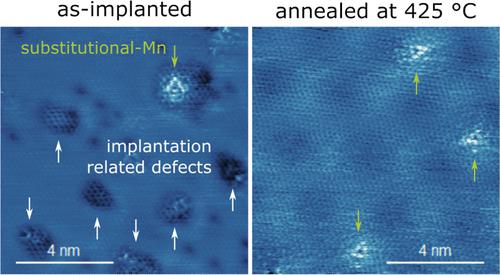当前位置:
X-MOL 学术
›
J. Phys. Chem. C
›
论文详情
Our official English website, www.x-mol.net, welcomes your
feedback! (Note: you will need to create a separate account there.)
Thermal Annealing of Graphene Implanted with Mn at Ultralow Energies: From Disordered and Contaminated to Nearly Pristine Graphene
The Journal of Physical Chemistry C ( IF 3.3 ) Pub Date : 2022-06-14 , DOI: 10.1021/acs.jpcc.2c00855 Pin-Cheng Lin 1 , Renan Villarreal 1 , Harsh Bana 1 , Zviadi Zarkua 1 , Vince Hendriks 1 , Hung-Chieh Tsai 2, 3 , Manuel Auge 4 , Felix Junge 4 , Hans Hofsäss 4 , Ezequiel Tosi 5 , Paolo Lacovig 5 , Silvano Lizzit 5 , Wenjuan Zhao 5 , Giovanni Di Santo 5 , Luca Petaccia 5 , Steven De Feyter 6 , Stefan De Gendt 2, 3 , Steven Brems 2 , Lino M. C. Pereira 1
The Journal of Physical Chemistry C ( IF 3.3 ) Pub Date : 2022-06-14 , DOI: 10.1021/acs.jpcc.2c00855 Pin-Cheng Lin 1 , Renan Villarreal 1 , Harsh Bana 1 , Zviadi Zarkua 1 , Vince Hendriks 1 , Hung-Chieh Tsai 2, 3 , Manuel Auge 4 , Felix Junge 4 , Hans Hofsäss 4 , Ezequiel Tosi 5 , Paolo Lacovig 5 , Silvano Lizzit 5 , Wenjuan Zhao 5 , Giovanni Di Santo 5 , Luca Petaccia 5 , Steven De Feyter 6 , Stefan De Gendt 2, 3 , Steven Brems 2 , Lino M. C. Pereira 1
Affiliation

|
Ultralow-energy (ULE) ion implantation is increasingly being explored as a method to substitutionally dope graphene. However, complex implantation-related effects such as defect creation and surface contamination, and how they can be minimized by thermal annealing, remain poorly understood. Here, we address these open questions taking as the model case epitaxial graphene grown on Cu(111), which was subsequently ULE implanted with Mn at 40 eV and then studied as a function of annealing temperature under ultrahigh vacuum. While significant surface cleaning occurs at annealing temperatures as low as 200 °C, recovery from the implantation-induced disorder requires at least 525 °C. Upon high-temperature annealing, in the 600–700 °C range, the Mn atoms that were incorporated upon implantation as intercalated species (between graphene and the Cu surface) experience diffusion into the Cu layer, creating a subsurface alloy. Annealing at 700 °C restored implanted graphene to a nearly pristine state, with a well-ordered graphene lattice with substitutional Mn atoms and a well-defined Dirac cone. In addition to the insight into the complex physicochemical effects induced by thermal annealing, our results provide useful guidelines for future experimental studies on graphene that is modified (e.g., substitutionally doped) by using ULE ion implantation.
中文翻译:

在超低能量下注入锰的石墨烯的热退火:从无序和污染到近乎原始的石墨烯
超低能量 (ULE) 离子注入作为一种替代掺杂石墨烯的方法正被越来越多地探索。然而,复杂的注入相关影响,例如缺陷产生和表面污染,以及如何通过热退火将它们最小化,仍然知之甚少。在这里,我们以在 Cu(111) 上生长的外延石墨烯为例来解决这些悬而未决的问题,随后在 40 eV 下用 Mn 进行 ULE 注入,然后作为超高真空下退火温度的函数进行研究。虽然在低至 200 °C 的退火温度下会发生显着的表面清洁,但从植入引起的紊乱中恢复至少需要 525 °C。高温退火后,在 600–700 °C 范围内,在注入时作为插层物质(在石墨烯和铜表面之间)结合的 Mn 原子会扩散到铜层中,从而形成亚表面合金。在 700 °C 下退火将植入的石墨烯恢复到近乎原始的状态,具有有序的石墨烯晶格,具有取代的 Mn 原子和明确的狄拉克锥。除了深入了解热退火引起的复杂物理化学效应之外,我们的结果还为未来通过使用 ULE 离子注入改性(例如,替代掺杂)的石墨烯的实验研究提供了有用的指导。
更新日期:2022-06-14
中文翻译:

在超低能量下注入锰的石墨烯的热退火:从无序和污染到近乎原始的石墨烯
超低能量 (ULE) 离子注入作为一种替代掺杂石墨烯的方法正被越来越多地探索。然而,复杂的注入相关影响,例如缺陷产生和表面污染,以及如何通过热退火将它们最小化,仍然知之甚少。在这里,我们以在 Cu(111) 上生长的外延石墨烯为例来解决这些悬而未决的问题,随后在 40 eV 下用 Mn 进行 ULE 注入,然后作为超高真空下退火温度的函数进行研究。虽然在低至 200 °C 的退火温度下会发生显着的表面清洁,但从植入引起的紊乱中恢复至少需要 525 °C。高温退火后,在 600–700 °C 范围内,在注入时作为插层物质(在石墨烯和铜表面之间)结合的 Mn 原子会扩散到铜层中,从而形成亚表面合金。在 700 °C 下退火将植入的石墨烯恢复到近乎原始的状态,具有有序的石墨烯晶格,具有取代的 Mn 原子和明确的狄拉克锥。除了深入了解热退火引起的复杂物理化学效应之外,我们的结果还为未来通过使用 ULE 离子注入改性(例如,替代掺杂)的石墨烯的实验研究提供了有用的指导。











































 京公网安备 11010802027423号
京公网安备 11010802027423号